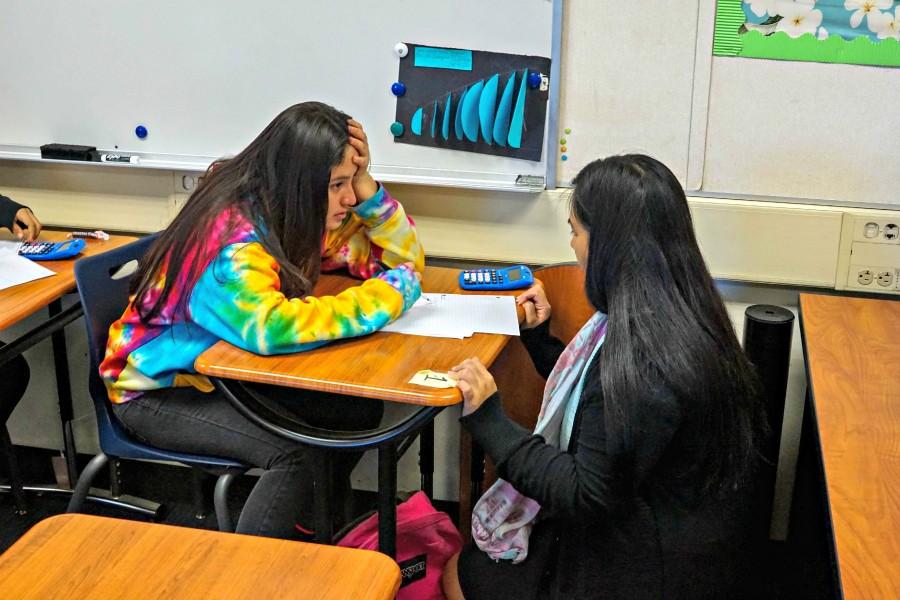Math placement policy highlights larger issue of achievement gap
Algebra I Enhanced teacher Laraine Ignacio helps a student with a math problem. The school district recently passed a math placement policy as part of its larger effort to reduce the achievement gap among students.
In response to a complaint from the Lawyer’s Committee for Civil Rights (LCCR) on racial bias in ninth grade math placement, the MVLA school board passed an official general policy in October, satisfying the LCCR enough to cause a withdrawal of its complaint. In passing the policy, the board also met requirements of a new California law mandating all school districts pass written math placement policies.
Improving the math placement process is part of a larger district effort to reduce the achievement gap. But the reasons that cause students to underperform are vastly complex. Students, teachers, staff and administrators should discover non-traditional ways to address parts of the gap and help all types of students achieve.
The previous policy looked at a variety of placement factors, including middle school grades and some teacher recommendations. The new, recently passed policy disregards teacher recommendations in an effort to eliminate subjective placement decisions. However, this changes little ― recommendations did not significantly affect the majority of placement decisions because they often aligned with the conclusions drawn from objective data, such as grades and test scores. While the updated policy may have addressed the California law and LCCR’s complaint, it will not significantly affect the intended targets.
But the policy is another step in addressing the achievement gap at our school. The disproportionate number of minority students who are placed into lower-level math classes need more attention than higher math class placement. There are larger issues, such as varying middle school class environments and socioeconomic factors, that set them up to struggle in high school math classes. These students often enter our school with a weak foundation in the subject and as a result, underperform.
Another issue is that students in the same support classes may enter with many different levels of experience. For example, in Algebra I, some students are repeating the course, while still reinforcing certain concepts from eighth grade. Others took pre-algebra in eighth grade and are learning all-new material. As a result, some students feel like the class is too slow, while others learn slowly for lack of motivation, forcing the teacher to slow the pace to accommodate everyone.
Many of these students also lack a strong connection to the campus. They lack the trust or confidence to approach teachers or peers for help. In fact, when they begin as freshmen, students often have a lack of trust in teachers and school in general.
“My dad always told me teachers won’t help me and will only give me trouble and homework, but now [after taking Skills classes] I know that the teacher is there to help,” a Skills student said.
Part of establishing trust is building on existing connections. A new Leadership course this year, piloted by a Skills teacher, attempts to increase former freshmen Skills students’ connectivity on campus and boost confidence. So far, the 12 sophomores and juniors in the class have already helped host several major events, such as Family Skills Night with the help of Latinos Unidos Caminando Hacia Afuera (LUCHA) and Spirit Week with ASB.
The students in the class say that working on these events helps them perform better in the rest of their classes and gives them a newfound sense of confidence. They are inspired to show other struggling peers how to be confident and how to value opportunities to succeed. This is exactly what underperforming students at our school need: a positive cycle of motivation, inspiration and life-skill building transferrable to their peers who are not necessarily in the course.
Underperforming students need different ways to succeed. No matter how many Skills, AVID and supervised study classes, tutorial centers or college and career centers our school has, there will always be students who don’t find support in traditional academic places. All students on campus should take the first step and ask where help is needed, then think outside the box for new solutions, activities and collaborations.
One example is peer-to-peer cooperation. As shown by the Leadership students’ collaborations with LUCHA and ASB, these partnerships increase underperforming students’ involvement.
Once students and staff find effective and unique solutions, the district will be better able to see which programs need extra resources and help in specific ways. If this school wants to be successful at closing the achievement gap, everyone should be on board to make this campus a better place.



